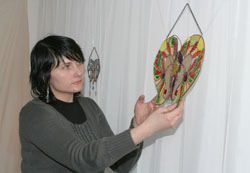Angels in the city
Stained-glass cherubim bring light and warmth
This model of the world is created by Natalia Haidash in her City of Angels displayed at the art gallery Svitlytsia in Kyiv. These winged creatures are faceless and sexless, pure ideas of light in colorful sparkling glass, which is popularly believed to ward off demons.
“An angel is your guardian and protector. For example, I have three angels. I see them in my dreams whenever there is some trouble in the offing,” says the artist, who displays more than 20 stained glass angels created using the tiffany technique. The latter allows the artist to make stained glass ensembles by putting together the tiniest of components soldered with copper foil. Such stained glass windows are stronger than the classical ones based on lead frameworks and far more beautiful; they allow components to be placed at varying angles and three-dimensional compositions of any size to be created. This technique has freed stained glass from the confines of cathedrals so that it can be used for cozy fixtures in a bedroom or as a luxurious mirror frame in the drawing room, or as a ceiling, door, or part of the wall.
Making things of stained glass is daily routine for Natalia, but she always prepares something special for an exhibit. This time she made angel-shaped candlesticks, with the light shining through each figure and the pieces of glass lending it an array of colors. The contours of the angels depend on color. The cold winter tones are associated with straight edges, whereas the pastel, pink, and green ones — with soft and rounded lines.
There are tall candlesticks (reaching 50 centimeters in height) that match full format stained glass compositions in terms of size and design complexity, and small ones that resemble icon lamps. Also, cherubim hanging from the wall that look more like refined openwork lockets of three-dimensional copper crosspieces.
Holding such a weightless masterpiece, it is hard to believe that anyone could dare damage it, yet the fact remains that the items on display of her first personal exhibit were vandalized at the artist’s studio in Lviv on this New Year’s Eve. Previously, the twelve lion-shaped chandeliers (each symbolizing a month of the year) were displayed at Lviv’s Zelena Kanapa Gallery. Later, one of them, “December,” was displayed during Oksana Karavanska’s fashion show and submitted to the competition “Pryimachenko and I” as the only work of art from Lviv. It thus survived the fire that destroyed the artist’s studio — as did two other items that were on display at other galleries in Lviv at the time. The rest of the stained glass lions now exist only on photos, to be used as illustrations for a calendar.
Haidash is never content with what she has accomplished and does not seem too upset [by the fire]. She has many creative plans, the most ambitious one being a big five-to-seven-meter Christmas tree executed using the tiffany technique, to be installed in the hall of a shopping malls. When asked why, she replies, “It will be a spectacular sight. I want people to see it and forget everything but the holiday.” Incidentally, such a Christmas tree would have practical use, saving hundreds of pines that are annually chopped down before the New Year.
Natalia feels she has enough creative strength to make her dreams come true: “I have long dreamed of making stained glass compositions, even as a student at the Kosiv College of Art. What stopped me was the fear of cutting glass.”
Haidash overcame this fear several years after graduating from Lviv Art Academy, where she studied at the Department for Monumental Art, and has occupied herself with her favorite art for nearly seven years. When making works of stained glass she abides by the simple laws of harmony of colors, line, and form: “My hands seem to have been created for working stained glass; I draw every line, then erase it several times, yet I never make sketches. They are all in my mind.” The artist easily does the “man’s job” of cutting out parts and soldering contours.
Also, she paints her works, decorates them with necklaces as a tribute to the folk tradition. In fact, this is what makes her creations especially attractive — “the way accents do in watercolors or salt in a cake,” says Haidash.
She believes that her works are meant to bring people joy. Last year she created a small Christmas tree for a Christmas exhibit in Lviv, as a prototype of her cherished dream of a big one, as well as the so-called shopka (a hut representing the scene of Jesus’ birth), which she shaped as a three-dimensional construction lit from the inside and containing the figures of Jesus’ family.
Natalia tries to combine elements of art and daily life in her work: a beautiful work of art has to have some practical use. She works hard to create things fit for household use: stained glass windows, chandeliers, candlesticks, big and small cherubim.
Her exhibit in Kyiv will be open until March 1. Visit it, and, who knows, you may feel you can never forget this miracle of art.






